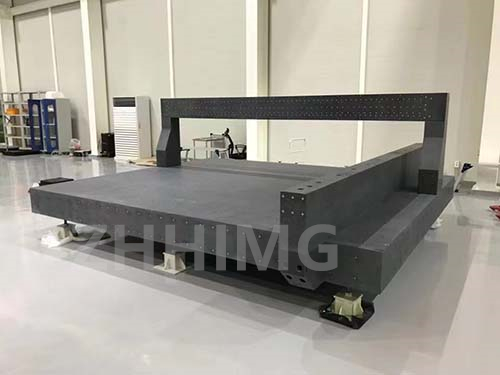In the production of LCD/OLED panels, the performance of the equipment gantry directly affects the screen yield. Traditional cast iron gantry frames are difficult to meet the requirements of high speed and precision due to their heavy weight and slow response. Granite gantry frames, through material and structural innovation, have achieved "40% weight reduction while maintaining ultra-high rigidity", becoming a key technology for industry upgrading.
I. Three Major Bottlenecks of Cast Iron Gantry Frames
Heavy weight and strong inertia: The density of cast iron reaches 7.86g/cm³, and the 10-meter gantry frame weighs over 20 tons. The positioning error during high-speed start and stop is ±20μm, resulting in uneven coating thickness.
Slow vibration attenuation: The damping ratio is only 0.05-0.1, and the vibration takes more than 2 seconds to stop, causing periodic defects in the coating, accounting for 18% of the defective products.
Long-term deformation: Large elastic modulus, insufficient toughness, flatness error expands to ±15μm after 3 years of use, and high maintenance cost.
Ii. The natural advantages of granite
Lightweight and high strength: Density 2.6-3.1g/cm³, weight reduction by 40%; The compressive strength is 100-200 mpa (equivalent to cast iron), and the deformation is only 0.08mm (0.12mm for cast iron) when a load of 1000kg is applied over a span of 5 meters.
Excellent vibration resistance: The internal grain boundary structure forms natural damping, with a damping ratio of 0.3-0.5 (6 times that of cast iron), and the amplitude is less than ±1μm under 200Hz vibration.
Strong thermal stability: The coefficient of thermal expansion is 0.6-5×10⁻⁶/℃ (1/5-1/20 for cast iron), and the expansion is less than 100nm when the temperature changes by 20℃.
Iii. Bionic Innovation in Structural Design
Honeycomb ribbed plate structure: It simulates the mechanical distribution of a honeycomb, with a 40% reduction in weight but a 35% increase in bending stiffness and a 32% decrease in stress.
Variable cross-section crossbeam: The thickness is dynamically adjusted according to the force, with the maximum deformation reduced by 28%, meeting the high-speed movement requirements of the coating head.
Nanoscale surface treatment: Magnetorheological polishing achieves a flatness of ±1μm/m, diamond-like carbon coating (DLC) increases wear resistance by five times, and the wear per million movements is less than 0.5μm.
Iv. Future Trends
Intelligent upgrade: Integrating optical fiber sensors and AI algorithms, it can compensate for environmental interference in real time, with the target error controlled within ±0.1μm.
Green manufacturing: The carbon footprint of recycled granite materials is reduced by 60%, while 90% of their performance is retained, promoting a circular economy.
Summary: The granite gantry frame has solved the problem of traditional materials that "reducing weight must decrease rigidity" through the combination of "mineral properties + bionic design + precision processing". The core logic lies in the utilization of the honeycomb structure of natural minerals and modern mechanical simulation to achieve the optimization and reconstruction of material properties, providing a green solution that takes into account both efficiency and precision for LED/OLED production. This innovation is not only a victory of materials, but also a model of interdisciplinary technological integration, which is helping the global display industry move towards higher precision and lower energy consumption.
Post time: May-19-2025

